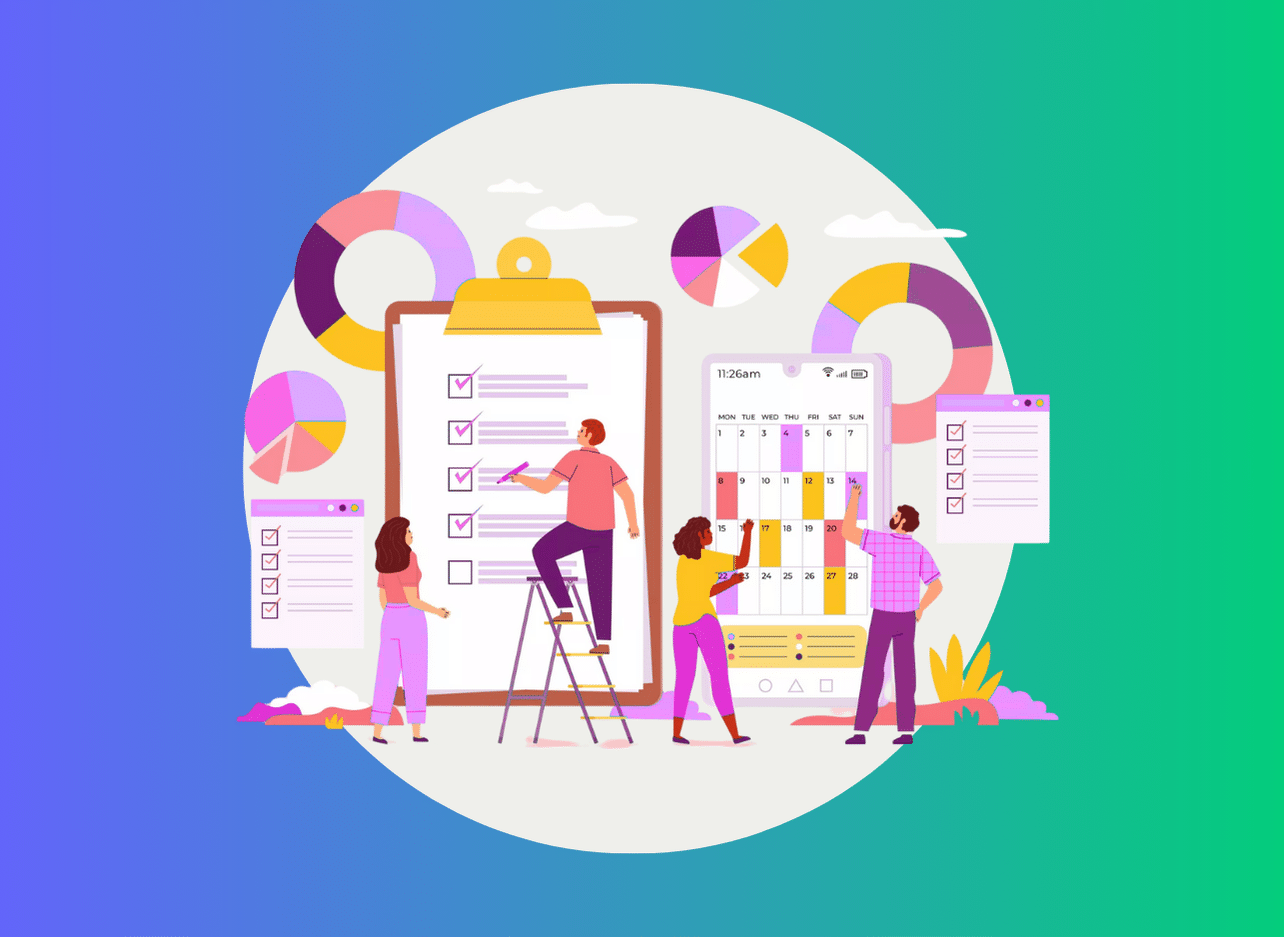Comment choisir le bon outil PPM pour piloter un portefeuille de projets ?
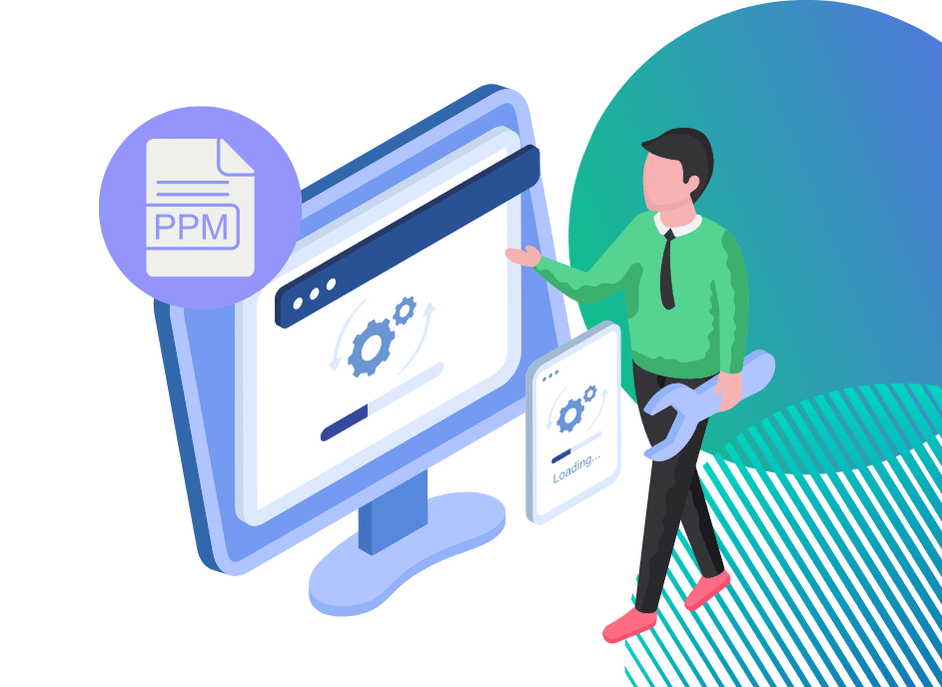
La gestion d’un portefeuille de projets, ou Project Portfolio Management (PPM) en anglais, est l’ensemble des techniques, outils et lignes directrices qui permettent d’organiser les ressources d’une entreprise pour mener à bien plusieurs projets simultanément.
Avec une bonne gestion et les bons outils, de meilleures décisions sont prises pour optimiser le temps, les ressources et les coûts alloués à la réalisation des projets.
Qu’est-ce qu’un outil PPM ?
Un outil PPM est spécialement conçu pour répondre aux besoins de la gestion d’un portefeuille de projets. Son but est de vous aider à atteindre simultanément les objectifs de chaque projet.
Afin de pouvoir prendre des décisions stratégiques qui ne risquent pas d’entacher un autre projet, les outils de portfolio de projet permettent de suivre l’état de santé des missions une à une, mais aussi en tant qu’ensemble.
Pour faciliter l’alignement du portfolio de projets aux objectifs commerciaux, et notamment la priorisation en fonction des objectifs de chaque missions, l’utilisation d’un logiciel PPM est indispensable pour assurer le succès commercial de votre activité.
Ce type de système possède des fonctionnalités de gestion de projet permettant de regrouper l’utilisation des ressources afin que l’information soit partagée et coordonnée au mieux pour répondre aux besoins individuels de chaque tâche.
Sans outil PPM intelligent, la planification des projets risque d’être mise à mal par des soucis de conflits de ressources, ou encore de coupures budgétaires liées à des coûts non surveillés.
Quelles sont les fonctionnalités d’un outil PPM ?
Concrètement, un outil PPM permet de piloter plusieurs projets simultanément, tout en intégrant la capacité en ressources globale afin de planifier les tâches, les talents ou les budgets sans créer de conflits.
- Centralisation des données : les informations sont regroupées en une seule plateforme, permettant de déduire chaque ressources utilisées sur un projet pour une meilleure prise en compte des capacités.
- Planification de projet : l’outil permet de créer des missions et les tâches qui leur incombent, d’en attribuer des délais, mais aussi de pouvoir modifier les plannings en fonction de l’évolution de l’activité.
- Gestion des ressources : il est en mesure de définir la capacité en ressources humaines, temporelles et financières de façon à rendre un meilleur état des lieux lors de la phase d’allocation et de planification.
- Analytique : des dashboards et bon nombres de reporting doivent soutenir le management et indiquer en temps réel et en prévisionnel où en est la performance d’un ou des projets.
L’outil PPM, un indispensable ?
L’outil PPM facilite précisément ce processus d’optimisation de la gestion de portfolio de projet car il permet une gestion efficace des projets et des opérations.
En configurant un budget qui assure la réalisation des objectifs, et qui met à jour la disponibilité des ressources au fur et à mesure qu’elle évolue, la planification est fluidifiée, et le risque de perte financière ou d’échec est grandement limité.
Il permet également de définir des tâches spécifiques et de désigner des responsables de manière agile, intuitive et coordonnée.
Il automatise les notifications et accélère la communication entre les parties pour notifier tout écart dans l’exécution planifiée de ces tâches. Ceci est très important pour la gestion correcte des délais et pour détecter les lacunes qui peuvent empêcher l’exécution des tâches selon les paramètres établis.
Les avantages d’un outil PPM en gestion de portefeuille
Le contrôle et le suivi de plusieurs projets simultanés
Pour s’assurer que tout se passe bien comme prévu, il est nécessaire de suivre la performance des projets. Cela peut se faire plus facilement avec un outil PPM, grâce à des rapports, des tableaux de bord et des alertes.
La première chose à faire est d’établir vos KPIs, facilement configurables, sur lesquels le suivi sera effectué. Ces KPI peuvent être strictement financiers.
Il est possible d’avoir une gestion des contrats qui surveille jusque dans les moindres détails les marges bénéficiaires de chaque projet, l’état d’avancement, les rapports de pertes et profits, etc.
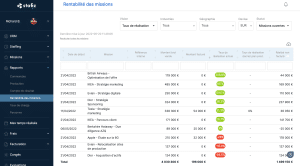
Suivez la rentabilité de vos différents projets au même endroit.
Mais ces indicateurs peuvent aussi se concentrer sur la gestion du personnel et les ressources humaines, ou toute autre valeur pertinente en fonction des valeurs et de la philosophie de l’entreprise.
Le logiciel GPP est un outil transversal qui permet de suivre les besoins et les objectifs des différents secteurs de l’entreprise.
Le département des ressources humaines peut veiller à l’équilibre de la charge de travail, ou assurer le développement professionnel des employés par le biais de projets actuels et futurs. Et, dans le même temps, le service comptable et financier pourra vérifier que les dépenses allouées à une certaine activité correspondent bien à ce qui avait été prévu et que la marge est respectée.
Ainsi, un outil PPM apporte de l’efficacité à l’ensemble de l’entreprise, ainsi qu’aux clients eux-mêmes, qui obtiendront les résultats escomptés dans leurs projets.
Découvrez notre guide dédié au suivi de projet pour en savoir plus.
Une gestion holistique du portefeuille de projets
Le point fort d’un outil PPM est qu’il permet une gestion conjointe de la qualité du portefeuille de projets, basée sur l’optimisation des ressources communes et limitées de chacun d’entre eux.
Dans le fonctionnement quotidien des entreprises, des événements imprévus surviennent – comme l’absence non programmée d’un professionnel pour cause de maladie, par exemple – qui nécessitent une gestion correcte du changement.
Dans ces circonstances, une méthodologie PPM qui permet une gestion conjointe, optimisée et simultanée des portefeuilles permet de ré-affecter les ressources avec facilité, sans subir les actions des autres clients.
Avec un outil PPM, vous disposez d’une vue d’ensemble unique. Cette vue d’ensemble qui vous permet de savoir où en est votre activité, et quelle est la meilleure décision à prendre pour atteindre les objectifs individuels et globaux.
Les capacités peuvent être planifiées et les ressources allouées efficacement. Définir les besoins exacts en fonction des types de projets que nous allons entreprendre. En même temps, cela permet d’établir un budget conforme à la réalité (concurrentielle) du client, sans réduire la rentabilité de l’entreprise.
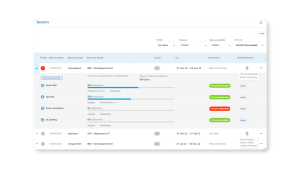
Les besoins en ressources de Stafiz vous indique les projets à la recherche de profil à staffer par rôle ou compétence. Les profils les plus adéquats vous sont automatiquement recommandés et sont staffables depuis cet écran.
En savoir plus sur l’allocation des ressources
L’intégration d’un outil PPM avec d’autres systèmes
Pour les entreprises qui ont besoin de rationaliser les processus internes, d’éliminer les obstacles administratifs et d’améliorer la communication et la gestion des parties prenantes, il est intéressant – voire impératif – lorsque cela est possible d’intégrer votre outil PPM à vos autres logiciels de gestion d’activité.
Imaginons que le service financier puisse connecter son application de gestion des dépenses aux factures qui sont attribuées, via la plateforme PPM, à un projet spécifique.
Ces dépenses sont automatiquement reprises dans la comptabilité sans qu’aucun membre du service financier ne doive intervenir. Cela permet d’économiser beaucoup de temps en procédures et sur les tâches administratives. Un temps qui peut être consacré à d’autres actions stratégiques à forte valeur ajoutée.
En outre, les erreurs possibles lors du transfert manuel d’informations d’un endroit à un autre sont réduites au minimum.
Des avantages qui pourraient être étendus à d’autres domaines de l’entreprise. Considérons maintenant un projet qui a nécessité l’exécution d’une série d’heures supplémentaires. Automatiquement et sans intervention humaine, les circonstances suivantes se produiront :
- Un surcoût est imputé au projet en question, qui n’était pas prévu initialement, et que le chef de projet aura détecté et maîtrisé.
- Le service financier réduira la prévision de trésorerie initiale, en raison de l’augmentation inattendue des frais de personnel résultant de ces heures supplémentaires.
- Les RH verront les informations salariales de ces travailleurs mises à jour automatiquement, grâce à la connexion API entre l’outil PPM et sa plateforme de création et de gestion des salaires.
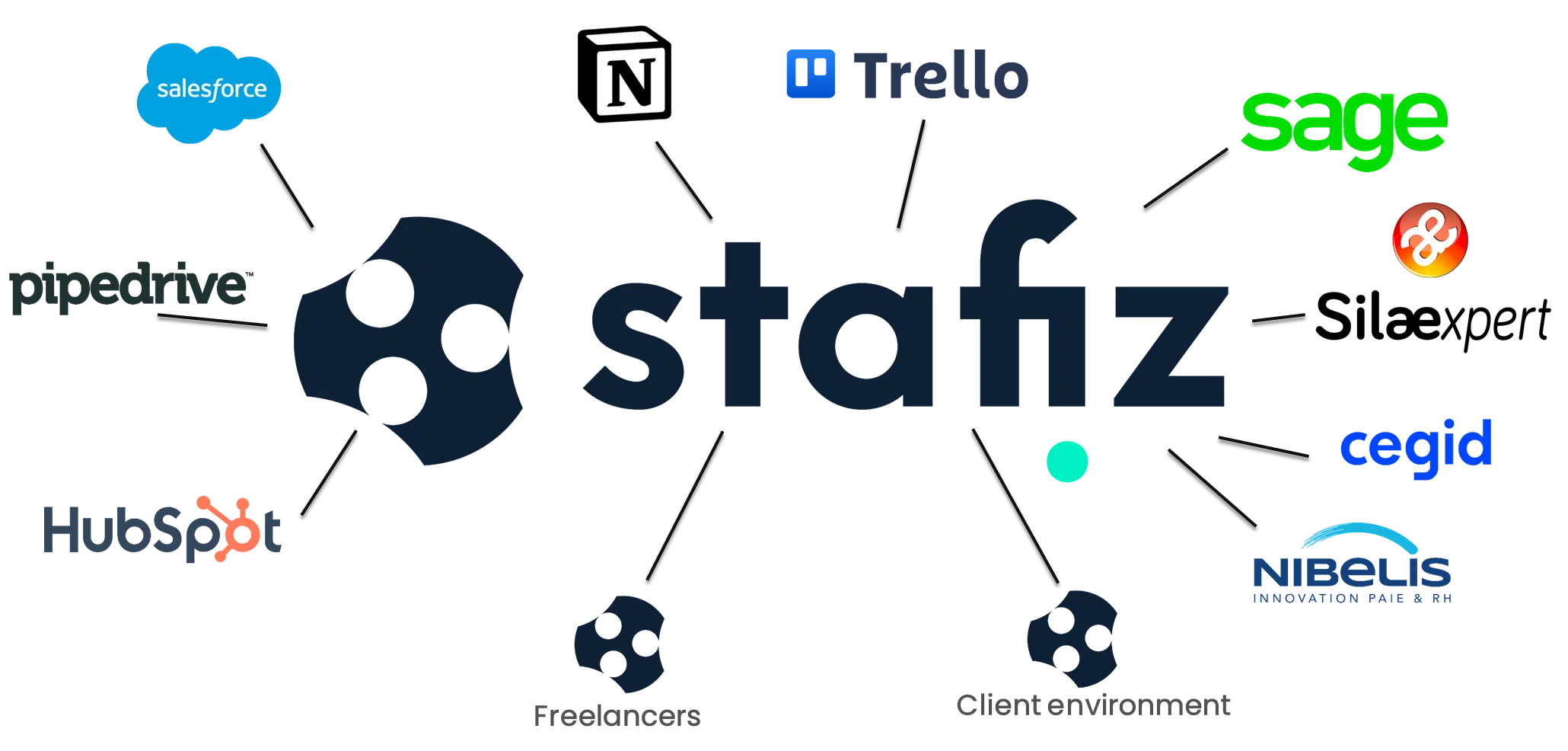
Stafiz s’intègre avec vos outils existants
Comment choisir un outil PPM ?
La première chose à faire pour choisir le meilleur outil PPM est de déterminer vos besoins. À partir de là, vous pourrez détecter les caractéristiques et fonctionnalités que votre gestionnaire de projet doit avoir en priorité.
Une fois que vous avez sélectionné les programmes qui correspondent aux besoins de votre entreprise, prêtez attention à trois autres paramètres : le prix, la facilité d’utilisation et le service à la clientèle.
Chaque entreprise a sa propre situation, ses propres processus et sa propre culture organisationnelle. En fonction de ces paramètres et du type de projet sur lequel vous travaillez, vous serez confronté à des défis et à des besoins qui détermineront les fonctionnalités et les caractéristiques du PPM.
J’ai besoin d’améliorer la vision stratégique et la conception du portefeuille de projets
Vous avez peut-être déjà expérimenté des erreurs en classant par ordre de priorité les projets dont les tâches ne peuvent être réalisées dans les conditions convenues.
Des erreurs peuvent aussi être commises dans la comptabilisation des coûts et des avantages au stade de la proposition, vous poussant ainsi à identifier comme des opportunités des projets qui ne le sont pas.
Vous aurez donc besoin d’indicateurs de performance clés consolidés et de projets réellement adaptés à leurs capacités, à leurs ressources et à leurs objectifs.
Les fonctionnalités à rechercher :
- configuration de KPI,
- tableau de bord de projet,
- module de gestion financière.
J’ai besoin d’optimiser les coûts
Que ce soit pour des raisons de compétitivité ou pour des besoins de trésorerie spécifiques, vous pouvez avoir besoin d’une excellente optimisation des coûts.
Pour se faire, vous aurez besoin d’un suivi complet des coûts, d’une évaluation des coûts pendant le projet, de stratégies supplémentaires de réduction des coûts, etc.
Les fonctionnalités à rechercher :
- création de budgets de projet,
- configuration des tâches projet,
- estimation des besoins en ressources
- gestion des coûts,
- suivi et gestion de la charge de travail,
- gestion des ressources : disponibilité des équipements, des employés et des outils,
- suivi de rentabilité en temps réel et prévisionnel,
- analyse des écarts,
- gestion des business units,
- dashboard de projet,
- base de donnée des projets historiques.
J’ai besoin d’une gestion efficiente des ressources
Il s’agit d’un problème qui touche particulièrement les grands cabinets de conseil ou encore les agences qui travaillent sur une multitude de projets simultanément avec des exigences élevées.
Les fonctionnalités à rechercher :
- moteur de recherche de profil collaborateur,
- création de besoins en ressources,
- gestion CRM,
- planning et phases de projet,
- prévisions budgétaires,
- suivi des performances (individuelles et collectives).
J’ai besoin d’analyser les projets pour identifier des axes d’amélioration
Vous faites peut-être partie d’une activité nécessitant flexibilité et agilité pour prendre les bonnes décisions stratégiques.
Grâce à la gestion des risques, vous pouvez détecter les erreurs et en tirer des leçons pour les projets futurs.
Les fonctionnalités à rechercher :
- Business Intelligence (BI),
- suivi des KPI
- comparaison entre réalisé et planifié,
- historique des projets,
- vues consolidées des projets.
J’ai besoin d’améliorer la collaboration et la gouvernance
Si vous avez identifié un problème de réunions à rallonge ou une difficulté à prendre des décisions en raison d’une hiérarchie très structuré lors d’évaluations de performance, vous être probablement à la recherche d’un outil ppm qui sera en mesure de s’adapter à vos processus tout en facilitant la collaboration.
Les fonctionnalités à rechercher :
- tableau de bord PPM avec vues globales et centralisées,
- différents niveaux d’accès,
- configuration facile pour différents types de profils,
- flux prédéfinis et automatisés de validation,
- visibilité sur la disponibilité des ressources humaines.
J’ai besoin d’améliorer les délais de livraison
Le respect des délais de livraison et le suivi des projets en cours est une problématique qui n’épargne généralement aucune activité de prestation de services.
Les fonctionnalités à rechercher :
- allocation des temps par projet et par personne,
- saisie des temps rapide et alertes de rappel,
- suivi des temps passés,
- rapports de production prévisionnelle et analyse des écarts,
- gestion automatisée de la facturation.
J’ai besoin d’intégrer l’outil PPM à d’autres logiciels
Si vous utilisez plusieurs logiciels dans votre environnement de travail, il est nécessaire de rationaliser les processus internes, d’éliminer les obstacles administratifs et d’améliorer la communication et la gestion des parties prenantes.
Les fonctionnalités à rechercher :
- connexion par API,
- gammes d’intégrations agiles avec tout types d’applications selon les fonctionnalités départements (RH, comptabilité, Helpdesk, IT).
Les autres critères à prendre en compte dans le choix d’un outil PPM
Outre les besoins spécifiques et techniques décrits ci-dessus, il existe d’autres critères communs à toutes les entreprises qui doivent faire appel à une plateforme PPM pour optimiser la planification de leur portefeuille de projets.
La qualité du service client
En ce qui concerne le service à la clientèle, il est souhaitable que l’éditeur du logiciel en question offre un large éventail de solutions pour accompagner la mise en place de l’outil et gérer les problèmes techniques.
Des simples manuels d’utilisation aux ressources vidéos avec lesquelles vous pouvez effectuer certaines configurations vous-même, jusqu’aux forums où vous pouvez poser des questions que la communauté expérimentée peut résoudre.
En plus, bien sûr, de confirmer qu’il dispose d’un service clientèle en ligne et par téléphone qui répond rapidement à vos questions en cas d’urgence.
